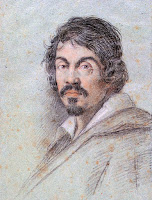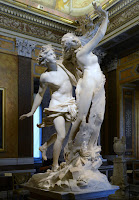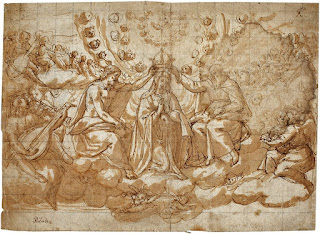 |
| David with the Head of Goliath (1607) by Caravaggio |
Presence of David and Goliath (Vienna)
 |
| Portrait of Caravaggio (1621) by Ottavio Leoni |
David with the Head of Goliath Analysis
 |
| The Resurrection (1619) by Cecco del Caravaggio |
Among three paintings of Caravaggio depicted on the bible scripture of David and Goliath, Vienna and Madrid versions have more characteristic features by having inner self portraits. Recognizably, the face of Goliath implies Cecco del Caravaggio that was a notname used by Francesco Boneri (or Buoneri), who was one of the early followers of Caravaggio, and famous for The Resurrection of Jesus painting. However, it is known that Caravaggio utilized Chiaroscuro technique to create dramatic scenes and make his art more naturalistic, paintings of the artists turned darker and more violent in this period, when he fled to Napoli then Malta. David and Goliath (Vienna) is one the early paintings that indicate this slight change in Caravaggio’s life and art style. David’s image in the painting, reveals some clues about the artist’s feeling about his crime. His victorious and confident looking points out that Caravaggio has not felt regret about his murdering. David stands over the ground with the head of Goliath. The weapon he put his large shoulders, is Goliath’s sword and used to cut the giants head according to biblical context. Caravaggio depicts the exact moment that David presents the head of Goliath to King Saul, who was the King of Israel.
 |
| Portrait of Cecco del Caravaggio as Severed Head of Goliath |
 |
| David the Young Shepherd |
Caravaggism, Tenebrism and Chiaroscuro
 |
| Apollo and Daphne (1622-1625) by Bernini |
 |
| Saint Peter's Baldachin (1623-1634) by Bernini |
 |
| Hero and Sibyl (1509-1532) by Ugo da Carbi |
 |
| Saint Jerome (1644) by Jusepe de Ribera |
 |
| Tityus (1632) by Jusepe de Ribera |
 |
| Jacob's Dream (1639) by Jusepe de Ribera |
 |
| The Coronation of the Virgin by an Angel (16th Century) by Francisco Ribalta |
 |
| Still Life with Lemons Oranges and a Rose (1633) by Francisco de Zurbarán |
 |
| Basket of Fruit (1599) by Caravaggio |
David and Goliath in Real Life
David and Goliath (Caravaggio, Vienna)
 Reviewed by Articonog
on
May 17, 2020
Rating:
Reviewed by Articonog
on
May 17, 2020
Rating:
 Reviewed by Articonog
on
May 17, 2020
Rating:
Reviewed by Articonog
on
May 17, 2020
Rating:





No comments: